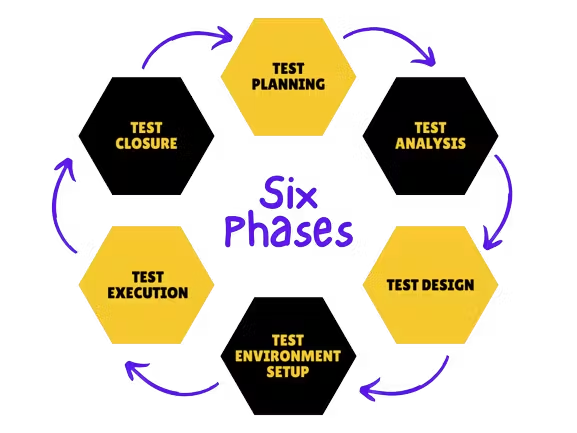4 Ways to Accelerate Your Software Testing Life Cycle
As a software developer, I understand that testing can often become a bottleneck in the software development life cycle, causing delays in the overall process, and It is crucial to find ways to optimize and speed up testing to maintain efficiency
The software
testing life cycle is a critical phase in software development that ensures
the quality and reliability of a product. In today's fast-paced digital world,
businesses are constantly striving to deliver software faster while maintaining
high standards. Accelerating the software testing life cycle can help us
achieve this goal. In this blog, we will explore 4 ways to effectively speed up
our testing process without compromising on quality.
What is Software Testing Life Cycle?
Software Testing Life Cycle or also known as STLC is
a systematic approach to testing a software application to ensure that it meets
the requirements and is free of defects. It is a process that follows a series
of steps or phases, and each phase has specific objectives and deliverables.
The main goal of the STLC is to identify and document any
defects or issues in the software application as early as possible in the
development process. This allows for issues to be addressed and resolved before
the software is released to the public.
Type of STLC phases
- Test
Planning: This phase involves defining the scope of testing,
identifying the test cases, and creating a test plan.
- Test
Analysis: This phase involves understanding the software
requirements and identifying the specific areas that need to be tested.
- Test
Design: This phase involves creating the test cases that will be
used to verify the software requirements.
- Test
Environment Setup: This phase involves setting up the environment
in which the software will be tested.
- Test
Execution: This phase involves executing the test cases and
recording the results.
- Test
Closure: This phase involves analyzing the test results,
documenting the defects, and closing the test cases.
Ways to speed up software testing life cycle
1. Test automation
It is a powerful technique that can significantly speed up
the software testing life cycle. By automating repetitive and time-consuming
tasks, testers can focus on more complex scenarios and critical areas. There
are various tools and frameworks available in the market to facilitate test
automation, such as Cypress, Selenium, Appium, Keploy and JUnit.
Automated tests can be executed quickly and repeatedly,
enabling faster feedback on software changes. Regression testing, which
involves retesting previously validated functionalities, can be particularly
time-consuming. By automating regression tests, you can ensure that new updates
do not introduce unexpected bugs and save valuable time during each release
cycle.
It is crucial to identify the right test cases
for automation. Tests that are stable, repeatable, and require minimal
manual intervention are ideal candidates. However, it is important to strike a
balance and avoid over-automating tests that are prone to frequent changes, as
maintaining such tests can become cumbersome.
2. Parallel testing
It is a technique that involves running multiple tests
simultaneously on different environments or devices. This approach can
significantly reduce the overall testing time by distributing the workload
across multiple resources.
One way to implement parallel testing is by leveraging
cloud-based testing platforms. These platforms offer a vast array of virtual
environments and devices that can be easily provisioned and scaled up or down
based on testing needs. By running tests in parallel, you can increase test
coverage, identify defects faster, and expedite the feedback loop.
Parallel testing is particularly useful when performing
compatibility testing across different operating systems, browsers, or mobile
devices. It allows testers to validate software functionality across a wide
range of configurations efficiently, ultimately reducing time to market.
3. Shift-Left testing
Shift-left testing is an approach that involves adding
testing activities earlier in the software development life cycle.
Traditionally, testing is performed towards the end of the development process,
leading to delays and rework if defects are identified. By shifting testing
activities left, organizations can detect and address issues early, preventing
them from becoming more significant problems downstream.
One way to implement shift-left testing is by involving testers
in the requirements gathering and design phases. This collaboration allows
testers to provide valuable insights and identify potential pitfalls or
ambiguities in the requirements.
In addition, integrating automated unit tests into the
developers' workflow can help catch defects early. Developers can run these
tests locally to ensure that their code changes do not break existing
functionalities. This approach not only accelerates the identification of
issues but also fosters a culture of quality throughout the development
process.
4. Continuous Integration and Continuous Testing
Continuous Integration (CI) and Continuous Testing (CT) are
practices that enable software teams to deliver changes more frequently and
with higher confidence. CI involves regularly integrating code changes from
multiple developers into a shared repo. With each integration, an automated
build and test process is triggered to catch integration issues early.
Continuous Testing complements CI by automating the
execution of various tests, including unit tests, integration tests, and
functional tests, as part of the CI pipeline. This ensures that each code
change is thoroughly tested, and any issues are identified promptly.
By implementing CI/CT practices, teams can achieve faster
feedback cycles, allowing them to identify and fix defects early. This approach
reduces the risk of introducing bugs into the main codebase and accelerates the
overall software testing life cycle.
Conclusion
In Conclusion, accelerating the software testing life cycle is crucial for organizations aiming to deliver high-quality software faster. Test automation, parallel testing, shift-left testing, and continuous integration and continuous testing are four effective ways to expedite the testing process without compromising on quality. By implementing these strategies, developers can gain a competitive edge, improve customer satisfaction, and increase their speed to market in today's rapidly evolving digital landscape.





Comments
Post a Comment